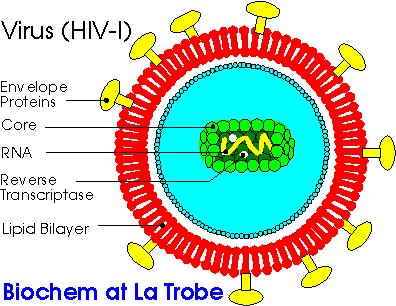

The combined observations and conclusions of cell biologists over many years led to the development of the cell theory, which states:
· All living things are composed of cells.
· Cells are the basic units of structure and function in living things.
· All cells come from preexisting cells.
![]() Back to choose another topic
Back to choose another topic
All living cells have some basic features in common. They all have some structure which separates the inside of the cell from the outside. They all have a jelly-like substance inside. They all have, at least at some stage in their lives, some genetic material. They all have structures which respond to the genes and produce proteins.
According to the above description of what all cells possess, it is possible to divide cells into two major groups:
This is known as the cell cycle and the time taken for it to be completed varies enormously between different types of cells. Cells such as those linig the intestines live only for a few days, others, such as nerves, last a lifetime.
The stages in the cell cycle, starting with a newly formed cell, can be simply divided into:
![]() Back to choose another topic
Back to choose another topic
CELL CYCLE
Since all cells come from preexisting cells, it follows that any one cell has a finite 'life', that is the time between when it is first formed until it either divides, or dies, or if it is a sex cell, fuses with another sex cell.
What triggers a normal cell to die or divide, and why the trigger sometimes fails to work correctly, as in cancer, where cell division becomes much more frequent and the cells do not die, is the subject of interesting research in Biochemistry.
![]() Back to choose another topic
Back to choose another topic
| PLANT CELLS | ANIMAL CELLS |
|---|---|
| Cell wall present (Therefore relatively rigid structure) | No cell wall (Therefore relatively flexible.) |
| May possess chloroplasts, containing chlorophyll (Cells with chloroplasts look green.) | No chloroplasts, no chlorophyll. |
| Large vacuole usually present | Vacoule, if present, usually small. |
| Aster the structure giving rise to spindles in mitosis. | Centrioles precursor on mitotic spindles. |
| ORGANELLE | In bacteria? | In plant? | In animal? | STRUCTURE & FUNCTION |
|---|---|---|---|---|
| Cell membrane(Plasma membrane) | Yes | Yes | Yes | Boundary between intracellular & extracellular environments. Regulates entry/exit of substances. |
| Cell wall | Yes, usually | Yes | No | Rigid structure providing support for cell. |
| Cytoplasm | Yes | Yes | Yes | Jelly-like substance filling intracellular space, contains dissolved substances. |
| Cyto-skeleton | No | Yes | Yes | Network of fine tubes and threads. Provides internal structural support. |
| Centrioles | Rarely | No, but aster is similar. | Yes | Paired rods which help organise microtubules during mitosis. |
| Nucleus | No | Yes | Yes | Membrane-bound structure containing cells' genetic information (DNA) and support molecules. |
| Nucleolus | No | Yes | Yes | Small structure within nucleus. Site of production of ribosomal RNA. |
| Nuclear Membrane | No | Yes | Yes | Boundary between nucleus and cytoplasm. Regulates passage of materials between the two. |
| Flagella, pili or cilia | Sometimes flagella or pili | Rarely, but some specialised cells may. | Only present in some specialised cells. | Structures used to enable movement of cells or sometimes to propel substances across outer surface of the cell. Predominantly protein in composition. |
| Mitochondria | No | Yes | Yes | Membrane bound organelles. Folded membranes within contain enzymes for aerobic respiration. (A little DNA in here too.) |
| Chloroplasts | No | Only in photosynthetic cells | No | Membrane bound organelles. Folded membranes within contain chlorophyll and enzymes for photosynthesis. (A little DNA in here too.) |
| Vacuole | No | Yes, often large | Unusual, and small if present. | Membrane bound area filled with water and assorted solutes. Role in maintenance of water balance of the cell. |
| Ribosomes | Yes | Yes | Yes | Small organelles at which protein synthesis occurs. May be free floating or membrane-bound. |
| Endoplasmic reticulum (ER) -smooth | No | Yes | Yes | Network of flattened membranes forming tunnels. Enzymes assisting synthesis of some lipids and final processing of proteins found here. |
| Endoplasmic reticulum -rough | No | Yes | Yes | Similar to smooth ER, but with ribosomes embedded in membrane. Proteins to be exported from cell produced here. |
| Golgi apparatus (aka Golgi Body) | No | Yes | Yes | Stacks of saucer shaped membranes where export proteins are modified and stored prior to entering secretory vesicles for exocytosis. |
| Lysosomes | No | Yes | Yes | Membrane bound structure containing enzymes which break down toxic or unwanted molecules. |
| Plastids | No | Yes | No | Membrane bound structures with varied functions. Leucoplasts - starch storage. Chromoplasts - coloured pigments within (eg flower petals). |
| Vesicles | No | Rare | Yes | Packages for storage (eg fat droplets) or temporary transport associated with endocytosis/exocytosis. |


This page is maintained by Jenny Herington, who can be contacted at bio_cat@bioserve.latrobe.edu.au by email, Last update : 21 Feb. 97